Pyotr Gannushkin
Pyotr Borisovich Gannushkin (Russian: Пётр Бори́сович Га́ннушкин; March 8, 1875 – February 23, 1933) was a Russian psychiatrist who developed one of the first theories of psychopathies known today as personality disorders.[1] He was a student of Sergei Korsakoff and Vladimir Serbsky. Not only did he manage to delineate certain organizational tasks of social psychiatry, but he also clearly formulated the main methodological aim of social psychiatrists, to combine methods of individual clinical analysis with sociological research and generalization.[2][3]
Pyotr Borisovich Gannushkin | |
|---|---|
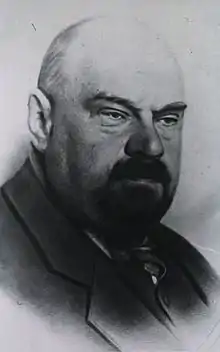 Pyotr Borisovich Gannushkin circa 1930 | |
| Born | 8 March 1875 Novosyolki (now known as Starozhilovsky District), Ryazan Governorate, Russian Empire |
| Died | 23 February 1933 (aged 57) |
| Resting place | Novodevichy Cemetery Moscow |
| Nationality | Russian |
| Citizenship |
|
| Alma mater | Imperial Moscow University (1898) |
| Known for |
|
| Spouse | Sofia Vladimirovna Gannuskina (née Klumova) |
| Scientific career | |
| Fields | Psychiatry Neuropsychiatry Psychology |
| Institutions |
|
| Thesis | Paranoia acuta (1904) |
| Doctoral advisor | Sergei Korsakoff |
| Other academic advisors | Vladimir Serbsky Sergei Sukhanov |
Formative Years
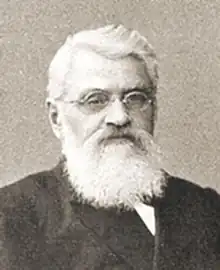
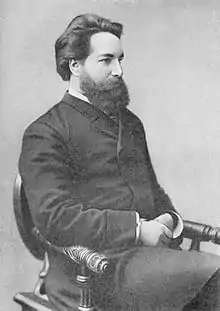
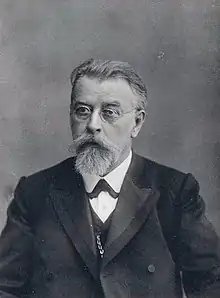
Early life and education
Pyotr Borisovich Gannushkin was born in the Russian Empire in 1875 in the village of Novosyolki in the Pronsk district of the Ryazan Governorate (the present-day Ryazan Oblast). His father Boris was a physician, a compassionate and precise man. His mother Olga (née Mozharova) came of an impoverished Russian landed family. Well-bred and educated, she was fluent in French and German, interested in philosophy, and fond of music, poetry and art. She was, moreover, a gregarious and kind-hearted woman.[4][5]
In his early years, Pyotr was educated by his mother. After a while, the family moved to Ryazan, the regional capital, where his father started teaching at a high school for boys. Soon after his 9th birthday, the young Gannushkin enrolled at the same school. An excellent student, Pyotr was always sociable, honest, and inclined to irony; he nursed a dislike for severe discipline. During his school years, he edited his own home journal.[6]
Gannushkin's sister Maria noted in her memoirs that Pyotr never told anyone which profession he intended to pursue. When he turned 13, however, Gannushkin's keen interest in "personology" and human mentality became apparent. It was then that he read Sechenov's 1863 monograph "Brain Reflexes", a successful attempt to describe the physiological mechanisms of mental activity.
University years
In 1893 Gannushkin graduated from the high school with a gold medal, the highest award, and entered the department of medicine at Moscow State University. In his third year of studies, he finally decided to become a psychiatrist after being influenced by such university professors as Aleksei Kozhevnikov and Sergei Korsakoff.
All the students, including Gannushkin, were fascinated by the way Korsakoff interacted with the mentally disabled. As Korsakoff explained, "mental patients should not be regarded as soulless creatures: they should be considered personalities familiar to everyone who is somehow related to them."[7]
In addition to attending lectures and recitals during his university years, Gannushkin served as an orderly with the responsibilities of a junior medical staff member.[8][9]
Career and Biography
Gannushkin graduated from Moscow University in October 1898. He turned down a proposal to become a permanent resident physician, because it then included superintendent's responsibilities. During the next years, up to 1902, he was a non-resident of the psychiatric hospital. He worked in the outpatient clinic and wrote a variety of scholarly works.
In 1901, for example the French journal Medico Psychological Annals (French: Annales médico-psychologiques) he published a monograph called "Voluptuousness, cruelty and religion" (French: La volupté, la cruauté et la religion), which was subsequently banned in Russia. In it Gannushkin emphasized the close relation between religiosity, sexuality, and cruelty, using the example of Ivan the Terrible as an illustration. In many cases religious fanatics demonstrated cruelty, wrote Gannushkin, and vice versa, i.e. many cruel people were religious.[10][11]
In 1902, at the suggestion of Sukhanov, Serbsky, and Rossolimo, Gannushkin was made a full member of the Moscow Society of Neuropathologists and Psychiatrists (Russian: Московское общество невропатологов и психиатров). At the same time, he was elected a supernumerary assistant at the psychiatric hospital headed by Serbsky, after Korsakoff's early death from heart failure.[12]
Collaboration with Sergei Sukhanov
Korsakoff's assistant Sergei Sukhanov was willing to help young physicians, fostering them in word and in deed. Sukhanov was a proponent of the nosological approach. He demonstrated a remarkable power of observation. Borderline psychiatry, especially psychopathies and psychogenies, was among his main research interests. His inclination towards synthesis led Sukhanov to note both the scientific and social importance of this problem.
Sukhanov managed to stir Gannushkin's interest in these issues and the two developed friendly relations, publishing six research papers together. They preferred to study individual mental disorders rather than their mixed types, believing that this approach would contribute to the study of acknowledged diseases, the discovery of new mental disorders, and the development of psychiatric taxonomy. Sukhanov and Gannushkin distinguished a particular form of obsession and were the first to show the process whereby, at least in some cases, obsessions were transformed into schizophrenia.[13]
Acute paranoia (1904)
In 1904, Gannushkin submitted his thesis on "Acute paranoia" (Russian: Острая паранойя). It took the form of a sketch of the historical development of the theory of acute paranoia. The thesis opened with a description of the research of Vincenzo Chiarugi and Jean-Étienne Dominique Esquirol. The focus then shifted to works by Wilhelm Griesinger, Bénédict Morel, and Karl Friedrich Otto Westphal. Next Gannushkin presented observations made by Sergei Korsakoff, Vladimir Serbsky, Emil Kraepelin, and Eugen Bleuler. Finally Gannushkin gave a brilliant exposition of his own findings about paranoia.[4][14]
After his thesis was accepted and approved, Gannushkin became a privat dozent (i.e. freelance university lecturer) of the Department of Mental Disorders in the Moscow State University. It was then that he began to deliver his course of lectures on "The Theory of Pathological Characters" (Russian: Учение о патологических характерах).
In 1905, Gannushkin attended courses in postgraduate psychiatry at Kraepelin's clinic in Munich. Thereafter he became a proponent of Kraepelin's theory. The following year, Gannushkin visited St. Anne's Psychiatric Hospital (French: Hôpital Sainte-Anne) in Paris, where he familiarized himself with the work of Valentin Magnan, an influential figure in French psychiatry. In 1908 and in 1911 Gannushkin again attended postgraduate psychiatry courses at Kraepelin's clinic.
Resignation (1911) and post-Revolutionary career
In 1911 university autonomy became a crucial issue in Russia, leading to repressive measures by the Tsar's protégé Lev Kasso, the education minister. In 1911, together with other progressive scholars and scientists, Gannushkin left the university in protest. From 1906 until 1914, when he was drafted into the army, he worked as a resident physician at the Moscow Alexeyev Psychiatric Hospital (Russian: Московская Алексеевская психиатрическая больница), known today as the Kashchenko Mental Hospital (Russian: больница имени П. П. Кащенко). During this period Gannushkin and others set up a first-class research journal, The Korsakoff Journal of Neuropathology and Psychiatry (Russian: Журнал невропатологии и психиатрии имени Корсакова).
In 1917, after being discharged from the army for health reasons,Gannushkin returned in the Moscow Alexeyev Psychiatric Hospital. From 1918 onwards he was a professor in the Department of Psychiatry at the Moscow State University (from 1930 he was professor at the I.M. Sechenov First Moscow State Medical University) and director at the University Psychiatric Hospital: today this is known as the Korsakov Clinic of Psychiatry at the Sechenov Moscow Medical Academy (Russian: Клиника имени С. С. Корсакова АМН России имени И. М. Сеченова).
Some other aspects of his work
Gannushkin was one of the first psychiatrists to talk about the schizoid reaction type, the somatogenic and psychogenic reactions of schizoids.
In 1927, he identified the "epileptoid reaction type", which is usually characterized by repeated temporary reactions caused by the influence of psychogenic factors and unfavorable situations. This reaction type is expressed by symptoms of dysphoria, i.e. malicious actions combined with anger, anguish, and fear.[15] In many ways, this reaction type is akin to the behavior pattern typical for borderline personality disorder. As a psychotic episode, such reactions could happen during epidemic encephalitis, cerebral atherosclerosis, and brain injury.
Gannushkin also took part in the experimental study of hypnosis. He criticized Lombroso's theory of crime.[16]
Gannushkin was interested in psychoanalytical ideas, and made experimental use of psychoanalytic therapy. His stance on psychoanalysis is outlined in his "On Psychotherapy and Psychoanalysis" (Russian: О психотерапии и психоанализе).[17] Not a committed proponent of Freud's theory, Gannushkin did believe that under certain conditions psychoanalytical methods could be used as part of the process of treatment.[11][18]
Gannushkin regarded war and revolution as a "traumatic epidemic" affecting the entire population. There is a reciprocal influence, he used to say, between the mentality of the population and its life in society.[2][19]
Under Gannushkin's direction a new form of medical care for people with mental disorders was created in Russia. He helped to organise a network of psychoneurological out-patient clinics in the USSR. He worked on issues linked to the teaching of psychiatry and the prevention of mental illness.[20]
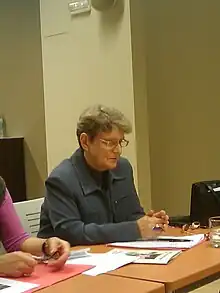

Marriage, son and grand-daughter
Pyotr Borisovich Gannushkin married the pianist Sofia Vladimirovna Klumova (1880-1945). They had one son Alexey Petrovich Gannushkin (1920-1974) who was an aircraft design engineer, USSR State Prize Laureate, and father of Svetlana Gannushkina (b. 1943).
Svetlana Alexeyevna Gannushkina is a mathematician and human rights activist, working particularly to help immigrants and refugees through the Civic Assistance NGO.[21][22] (She was reported to be a serious contender for the 2010 Nobel Peace Prize.) [23] A professor of mathematics at the Historical Archives Institute between 1970 and 1999, Gannushkina was a member of the presidential Council for the Development of Civil Society Institutions and Human Rights until her resignation in June 2012.
Personality and views on psychiatry
Gannushkin was a modest and diffident man and he disliked public speaking. When attending psychiatric conferences, he preferred to stay in the background. Only among fellow scientists and when lecturing to his senior students was Gannushkin able to speak his mind. An experienced clinician, he was a proponent of the natural science method who considered himself an enemy of pompous and meretricious declamation.[24][25]
Gannushkin's power of observation was enhanced by his erudition and ability to discern the most useful points in a variety of different monographs and articles. He recorded each new thought and accurately gathered all required materials. His lectures and clinical vignettes show how carefully he scrutinized and systematized all the research data he was working with.[18]
As L.A. Prozorov commented: "Gannushkin could stir the interest of young people in research, even if it was crude; he sought out and selected research scientists."[26] Remembering her husband, Sophia Gannushkina said, "Once he decided to do something, he grew fearless."
Throughout his life, Gannushkin believed that psychiatry and our life in society are closely connected. To him a psychiatrist was primarily a community worker. That is why, perhaps, he made psychopathies his main research subject.
"Our generation does not limit itself to psychiatric hospitals. Using the same approach, we visit schools, barracks, and prisons. We are not looking for those who need to be hospitalized, but for the half-normal, borderline types, those who represent intermediate steps. Borderline psychiatry, minor psychiatry... - here is a motto for our times, an area to which our actions must be directed in the immediate future."[19]
Death and influence
While Gannushkin was finishing his seminal work on the Manifestations of psychopathies: their statics, dynamics and systematic aspects (Russian: Клиника психопатий, их статика, динамика, систематика), his health quickly deteriorated. After long hesitation he agreed to undergo the proposed operation. The best Russian surgeons and physicians tried to save him, but he died on 23 February 1933. Before his death he managed to read his monograph after proofreading and approve it for publication. The book appeared that year following his death.[4]
Research papers written by Gannushkin and his followers represent a landmark in the theory of psychopathies in Russia. Among Russian psychiatrists, it was Gannushkin who developed the most accurate definition of various psychopathies (personality disorders).[27] Gannushkin had many followers, among who it is possible to distinguish three generations.
The first generation of disciples was formed of colleagues who worked under his direction: D.A. Amenitsky, I.N. Vvedensky, T.A. Geyer, V.A. Grombakh, M.O. Gurevich, P.M. Zinovyev, E.K. Krasnushkin, L.A. Prozorov, L.M. Rezenstein, M.Y. Serieysky, T.I. Yudin. The second generation was made up of Gannushkin's senior students: B.A. Belousov, A.G. Galachyan, F.F. Detengor, S.G. Zhislin, A.N. Zalmanov, M.Z. Kaplinsky, R.E. Lusternik, N.S. Molodenkov, A.N. Molokhov, N.I. Ozeretsky, D.S. Ozeretskovsky, T.P. Simpson, Y.A. Florenskaya, B.D. Fridman, Y.P. Frumkin, A.O. Edelstein. A third generation included his junior students (A.P. Alexandrova, A.M. Dubinin, O.V. Kerbikov, S.V. Krayts, A.Y. Levinson, D.E. Melekhov, V.M. Morozov, A.I. Ponomoryov, B.A. Famin, P.D. Fridman, Y.D. Shulman). Together, Gannushkin's followers made significant contributions to the development of psychiatry in Russia.[28][29]
In 1933, the Health Care Commissariat's Research Institute of Neuropsychiatric Treatment established an annual Gannushkin award.[30][31] In 1936, Moscow's Psychiatric Hospital No.4 was named after Gannushkin (Russian: Психиатрическая клиническая больница № 4 им. П.Б. Ганнушкина). Later a Gannushkin memorial museum was created inside the hospital. A river embankment in Moscow was also renamed in his honor.[32][33]
Gannushkin was immortalised in fiction as Professor Titanushkin, a character in Ilf and Petrov's satirical novel The Little Golden Calf (1931).
The theory of psychopathies
Pyotr Borisovich Gannushkin divided psychiatry into two principal categories: major psychiatric conditions, such as schizophrenia, bipolar disorder, etc., and minor psychiatric conditions (the psychopathies or personality disorders). The theory of psychopathies or "pathological characters" is regarded as Gannushkin's main contribution to the discipline.
In Manifestations of psychopathies: statics, dynamics, systematic aspects (1933), Gannushkin distinguished two types of pathological development: constitutional and situational. The situational development of psychopathy is evidently caused by trauma or distress: its onset is always marked by some serious mental change, after which everything becomes more or less static. While the statics of psychopathies refer to the actual substance of the subject, noted Gannushkin, the dynamics of psychopathies indioate the types, laws, and developmental schemes of psychopathies.[34]
Gannushkin did not consider psychopathies to be progressive mental states and contrasted them with serious mental disorders that caused retardation. Borderline psychiatry, he was at pains to emphasise, includes a wide range of different transitional steps and transient mental states. He acknowledged that psychopaths (i.e. those with personality disorders) have made substantial contributions to science, scholarship, art, and literature.[11][35]
Gannushkin delineated the three main signs of behavioral pathology that underlie psychopathies:
- maladaptation
- ubiquity
- stability
| Typology of psychopathies by Pyotr Borisovich Gannushkin[1] | ||||
|---|---|---|---|---|
| Cluster | Description | Possible DSM/ICD equivalent type(s)[36][37] | Possible Millon equivalent subtype(s) [38] | |
| I. Cluster of cycloids (Russian: Группа циклоидов) | Constitutionally depressive (Russian: Конституционально депрессивные) |
|
Depressive personality disorder. Can be combined with some avoidant, dependent, and masochistic features Dysthymia |
Restive, self-derogating or morbid depressive personality |
| Constitutionally excitable (Russian: Конституционально возбуждённые) |
|
Histrionic personality disorder with some narcissistic features Hypomania |
Vivacious histrionic personality | |
| Cyclothymics (Russian: Циклотимики) |
|
Cyclothymia | n.a. | |
| Emotionally labile or reactively labile psychopaths (Russian: Эмотивно-лабильные или реактивно-лабильные психопаты) |
|
Borderline personality disorder with some depressive or masochistic features | Self-destructive borderline personality | |
| II. Cluster of asthenics (Russian: Группа астеников) | Asthenics (Russian: Астеники) |
|
Avoidant personality disorder. Some dependent and negativistic features can also be present | Conflicted or phobic avoidant personality |
| Psychasthenics (Russian: Психастеники) |
|
Obsessive-compulsive personality disorder with some dependent features | Conscientious obsessive-compulsive personality | |
| III. Cluster of schizoids (Russian: Группа шизоидов) | Schizoids (Russian: Шизоиды) |
|
Schizoid personality disorder. Can be combined with some schizotypal, avoidant, and compulsive features | Remote, depersonalized or affectless schizoid personality |
| Dreamers (Russian: Мечтатели) |
|
A mix of schizoid, narcissistic, and histrionic features. Both schizotypal and avoidant features can also be present | schizotypal | |
| IV. Cluster of paranoiacs (Russian: Группа параноиков) | Paranoiacs (Russian: Параноики) |
|
Paranoid personality disorder. Can be combined with some compulsive, narcissistic, negativistic, and sadistic features | Obdurate, fanatic, querulous or malignant paranoid personality |
| Fanatics (Russian: Фанатики) |
|
Obsessive-compulsive personality disorder with some paranoid features | Puritanical obsessive-compulsive personality | |
| V. Cluster of epileptoids (Russian: Группа эпилептоидов) |
|
Antisocial personality disorder usually combined with some borderline features | Covetous antisocial personality Impulsive borderline personality | |
| VI. Cluster of hysterical characters (Russian: Группа истерических характеров) | Hysterical personalities (Russian: Истерические личности) |
|
Histrionic personality disorder. Can be combined with some dependent and negativistic features | Theatrical, appeasing or tempestuous histrionic personality |
| Pathological liars (Russian: Патологические лгуны) |
|
Histrionic personality disorder with some antisocial features Narcissistic personality disorder with some antisocial features Borderline personality disorder with some antisocial features |
Disingenous histrionic personality Unprincipled narcissistic personality Impulsive borderline personality | |
| VII. Cluster of unstable psychopaths (Russian: Группа неустойчивых психопатов) |
|
Haltlose personality disorder, Antisocial Personality Disorder with some schizoid and avoidant features Borderline personality disorder with some negativistic features |
Nomadic antisocial personality Petulant borderline personality | |
| VIII. Cluster of antisocial psychopaths (Russian: Группа антисоциальных психопатов) |
|
Antisocial personality disorder combined with some paranoid and sadistic features. Sometimes schizoid features can also be present | Malevolent antisocial personality | |
| IX. Cluster of constitutionally stupid (Russian: Группа конституционально глупых) |
|
Dependent personality disorder. Some masochistic and depressive features can also be present | Immature, accommodating or selfless dependent personality | |
Some elements of Gannushkin's typology were later incorporated into a theory developed by Andrey Yevgenyevich Lichko, another Russian psychiatrist interested in personality disorders together with their milder forms, the "accentuations of character" (Russian: акцентуации характера).[39]
Bibliography
Taken as a whole, Gannushkin's bibliography includes three monographs, 19 articles, nine introductory notes for monographs and anthologies, and approximately 100 reviews.
| Russian | Title in English | |
|---|---|---|
| Суханов С. А., Ганнушкин П. Б. Прогрессивный паралич по данным Московской психиатрической клиники. — 1901. | Sukhanov, S.A. & Gannushkin, P.B., "Progressive supranuclear palsy according to data from the Moscow Psychiatric Clinic", 1901. | |
| Суханов С. А., Ганнушкин П. Б. К вопросу о значении мышечного валика у душевнобольных. — 1901. | Sukhanov, S.A. & Gannushkin, P.B., "On the meaning of muscular embankment in people with mental disorders", 1901. | |
| Ганнушкин П. Б. Сладострастие, жестокость и религия. — 1901. | Gannushkin, P.B., "Voluptuousness, cruelty and religion", Annales médico-psychologiques, 1901. | |
| Суханов С. А., Ганнушкин П. Б. К учению о навязчивых идеях. — 1902. | Sukhanov, S.A. & Gannushkin, P.B., "On the theory of obsessions", 1902. | |
| Суханов С. А., Ганнушкин П. Б. К учению о меланхолии. — 1902. | Sukhanov, S.A. & Gannushkin, P.B., "On the theory of melancholy", 1902. | |
| Суханов С. А., Ганнушкин П. Б. К учению о мании. — 1902. | Sukhanov, S.A. & Gannushkin, P.B., "On the theory of mania", 1902. | |
| Суханов С. А., Ганнушкин П. Б. О циркулярном психозе и циркулярном течении. — 1903. | Sukhanov, S.A. & Gannushkin, P.B., "On circular psychosis and circular course", 1903. | |
| Ганнушкин П. Б. Острая паранойя, клиническая сторона вопроса. — 1904. | Gannushkin, P.B., Acute paranoia: clinical aspects, St Petersburg, 1904. | |
| Ганнушкин П. Б. Резонирующее помешательство и резонёрство. — 1905. | Gannushkin, P.B., "Tangential insanity and tangentiality", 1905. | |
| Ганнушкин П. Б. Психастенический характер. — 1907. | Gannushkin, P.B., "Psychasthenic character", 1907. | |
| Ганнушкин П. Б. Об эпилептоидном типе реакции. — 1927. | Gannushkin, P.B., "On the epileptoid reaction type", 1907. | |
| Ганнушкин П. Б. Клиника психопатий, их статика, динамика, систематика. — 1933. | Gannushkin, P.B., Manifestations of psychopathies: statics, dynamics, systematic aspects, 1933. | |
| Ганнушкин П. Б. Клиника малой психиатрии. — 1933. | Gannushkin, P.B., "Clinical manifestations in mild psychiatric syndromes", 1933. | |
| Ганнушкин П. Б. Избранные труды. — 1964. | Gannushkin, P.B., Selected works, 1964. | |
See also
- Theodore Millon (1928-2014) — a researcher of psychopathies, now known as personality disorders.
- Andrey Yevgenyevich Lichko (1926-1994) — a researcher interested in personality disorders along with their milder forms, the so-called accentuations of character.
References
- Ганнушкин П. Б. (2000). Клиника психопатий, их статика, динамика, систематика. Издательство Нижегородской государственной медицинской академии. ISBN 5-86093-015-1.
- Банщиков В. М. Большой друг больного (К 100-летию со дня рождения П. Б. Ганнушкина) // Здоровье. — 1975. — № 3. — С. 32.
- Вольф М. Ш., Гериш А. Г. Материалы к врачебной, научной и педагогической деятельности соратников и учеников П. Б. Ганнушкина // Проблемы бреда, пограничные состояния и вопросы организации психиатрической помощи: Тезисы научной конференции, посвящённой 100-летию со дня рождения проф. П. Б. Ганнушкина (г. Москва, 29–30 июня 1975 г.) / Под общ. ред. М. Ш. Вольфа. — М.: Б. и., 1975. — С. 80–89.
- Баженов Н. Н. История Московского доллгауза. — М., 1909. — С. 9.
- Гериш А. Г. Библиографическая хроника профессора П. Б. Ганнушкина // Проблемы бреда, пограничные состояния и вопросы организации психиатрической помощи: Тезисы научной конференции, посвящённой 100-летию со дня рождения проф. П. Б. Ганнушкина (г. Москва, 29–30 июня 1975 г.) / Под общ. ред. М. Ш. Вольфа. — М.: Б. и., 1975. — С. 61–72.
- Гериш А. Г. П. Б. Ганнушкин. — М.: Медицина, 1975. — 64 с.
- Завилянський І. Я. Пам’яті професора П. Б. Ганнушкіна, до 25-річчя з дня виходу в світ книги «Клініка психопатій» // Збірних наукових праць, присвячених 150-річчю Київської психоневрологічної лікарні (1806–1956). — Київ: Б. в., 1959. — Т. 1. — С. 293–299.
- Зейгарник Б. В. Пётр Борисович Ганнушкин и патопсихология // Проблемы бреда, пограничные состояния и вопросы организации психиатрической помощи: Тезисы научной конференции, посвящённой 100-летию со дня рождения проф. П. Б. Ганнушкина (г. Москва, 29–30 июня 1975 г.) / Под общ. ред. М. Ш. Вольфа. — М.: Б. и., 1975. — С. 98–100.
- Зиновьев П. М. Основные этапы научной работы П. Б. Ганнушкина // Советская невропатология, психиатрия и психогигиена. — 1933. — Т. 2, вып. 5. — С. 3–6.
- Gannouchkine P. B. La volupté, la cruauté et la religion // Annales médico-psychologiques. — 1901. — V. 14. — P. 353–375.
- Кербиков О. В. Проблема психопатий в историческом освещении. Сообщение третье: Учение о психопатиях в работах П. Б. Ганнушкина // Журнал невропатологии и психиатрии им. С. С. Корсакова. — 1958. — Т. 58, вып. 10. — С. 1253–1258.
- Vein, Alla (2009). "Sergey Sergeevich Korsakov (1854–1900)". J Neurol. 256 (10): 1782–1783. doi:10.1007/s00415-009-5289-x. PMC 2758215. PMID 19690905.
- Каннабих Ю. В. История психиатрии. — М.: Госмедиз, 1929. — С. 466–468.
- Кондрашкова О. В., Вольф М. Ш., Лурия Л. Р. Пётр Борисович Ганнушкин и психиатрическая больница, носящая его имя // Проблемы бреда, пограничные состояния и вопросы организации психиатрической помощи: Тезисы научной конференции, посвящённой 100-летию со дня рождения проф. П. Б. Ганнушкина (г. Москва, 29–30 июня 1975 г.) / Под общ. ред. М. Ш. Вольфа. — М.: Б. и., 1975. — С. 25–41.
- Ганнушкин П.Б. Об эпилептоидном типе реакции. Вестник современной медицины, 1927; № 23.- С. 1472–1473.
- Галачьян А. Г. К неопубликованным работам П. Б. Ганнушкина // Ганнушкин П. Б. Избранные труды / Под ред. О. В. Кербикова. — М.: Медицина, 1964. — С. 255–256.
- Ганнушкин П. Б. О психотерапии и психоанализе // Ганнушкин П. Б. Избранные труды / Под ред. О. В. Кербикова. — М.: Медицина, 1964. — С. 283–284.
- Фридман Б. Д. П. Б. Ганнушкин в учении о психопатиях // Советская невропатология, психиатрия и психогигиена. — 1933. — Т. 2, вып. 5. — С. 106–111.
- Ганнушкин П. Б. Острая паранойя (paranoia acuta). Клиническая сторона вопроса. — Диссертация д-ра мед. наук. — М., 1904. — 250 с.
- Эдельштейн А. О. Психиатрическая клиника // 175 лет 1-го Московского государственного медицинского института. — М.–Л., 1940. — С. 343–345.
- Ryabinina and Gannushkina, "Muslims on Faked Charges", Index on Censorship, 4, 2005.
- "Human Rights Defender in Russia: Svetlana Alekseevna Gannushkina". Amnesty International. 9 December 2008. Retrieved 19 January 2012.
- "Internet 'in running' for Nobel Peace Prize". BBC News. 10 March 2010. Retrieved 19 January 2012.
- Фридман Б. Д. П. Б. Ганнушкин как руководитель коллектива // Проблемы бреда, пограничные состояния и вопросы организации психиатрической помощи: Тезисы научной конференции, посвящённой 100-летию со дня рождения проф. П. Б. Ганнушкина (г. Москва, 29–30 июня 1975 г.) / Под общ. ред. М. Ш. Вольфа. — М.: Б. и., 1975. — С. 59–60.
- Фрумкин Я. П. Клинико-диагностический метод П. Б. Ганнушкина // Советская невропатология, психиатрия и психогигиена. — 1933. — Т. 2, вып. 5. — С. 10–11.
- Морозов В. М. Учение П. Б. Ганнушкина о малой психиатрии // Журнал невропатологии и психиатрии им. С. С. Корсакова. — 1975. — Т. 75, вып. 4. — С. 586–588.
- Эдельштейн А. О. Памяти учителя // Памяти Петра Борисовича Ганнушкина: Труды психиатрической клиники 1-го Московского медицинского института. — М.–Л.: Биомедиз, 1934. — Вып. 4. — С. 5–12.
- Хорошко В. К. Профессор П. Б. Ганнушкин (1875–1933) // Клиническая медицина. — 1933. — Т. 11, № 7–8. — С. 422–423.
- Шульман Е. Д. Амбулаторный приём П. Б. Ганнушкина // Памяти Петра Борисовича Ганнушкина: Труды психиатрической клиники 1-го Московского медицинского института. — М.–Л.: Биомедиз, 1934. — Вып. 4. — С. 32–36.
- Юдин Т. И. Памяти П. Б. Ганнушкина // Советская психоневрология. — 1933. — № 2. — С. 150.
- Юдин Т. И. П. Б. Ганнушкин и малая психиатрия // Памяти Петра Борисовича Ганнушкина: Труды психиатрической клиники 1-го Московского медицинского института. — М.–Л.: Биомедиз, 1934. — Вып. 4. — С. 22–26.
- Юдин Т. И. Очерки истории отечественной психиатрии — М.: Медгиз, 1951. — С. 323–324; 406–411.
- Edelstein A. In memoriam Peter Gannuschkin // Archiv für Psychiatrie und Nervenkrankheiten. — 1933. — Bd. 100. — S. 424–426.
- Левинсон А. Я. Неповторимый образ учителя // Проблемы бреда, пограничные состояния и вопросы организации психиатрической помощи: Тезисы научной конференции, посвящённой 100-летию со дня рождения проф. П. Б. Ганнушкина (г. Москва, 29–30 июня 1975 г.) / Под общ. ред. М. Ш. Вольфа. — М.: Б. и., 1975.— С. 53–55.
- Личко А. Е. Гражданин своей эпохи (100 лет со дня рождения П. Б. Ганнушкина) // Наука и религия. — 1975. — № 4. — С. 84–85.
- American Psychiatric Association (2000). Diagnostic and Statistical Manual of Mental Disorders DSM-IV-TR Fourth Edition (Text Revision). ISBN 978-0890420256.
- World Health Organization. ICD-10-CM: The Complete Official Draft Code Set. 2013 Edition. ISBN 978-1601516299.
- Millon, Theodore (2004). Personality Disorders in Modern Life, p. 378. John Wiley & Sons, Inc., Hoboken, New Jersey. ISBN 0-471-23734-5.
- Личко А. Е. Психопатии и акцентуации характера у подростков. — Речь, 2010. — ISBN 978-5-9268-0828-2.
External links
- "Труды клиники на Девичьем Поле" (notes on the psychiatric clinic on Devichye Pole)
- "Клиника малой психиатрии" (clinical manifestations in mild psychiatric syndromes)